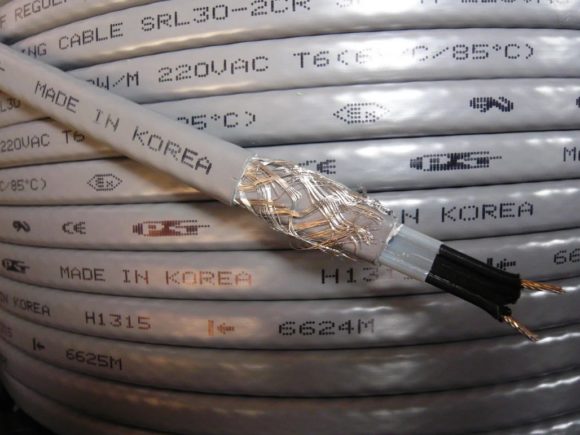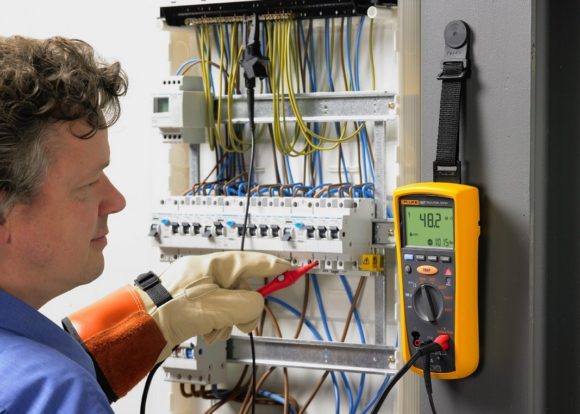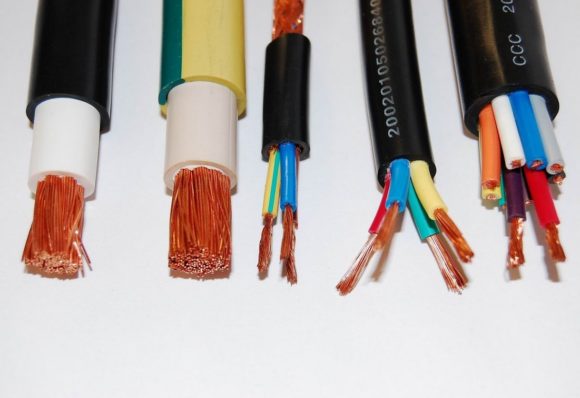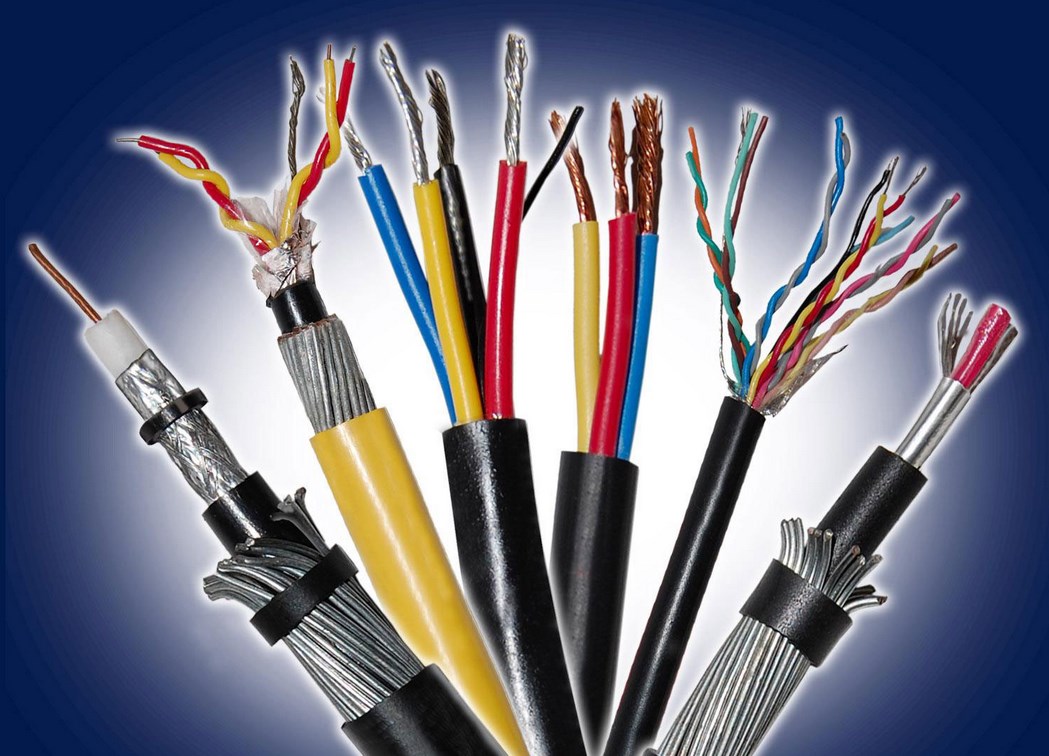Comfort in a house or apartment is hard to imagine without household appliances. Whether it is a TV, multimedia system or kitchen appliances, they cannot work without electricity. High power consumption is a dangerous factor that causes fire to wires. With a new installation or modernization of the old power supply network, the cross-section of current-carrying conductors is calculated, observing the rules for selecting cables and taking into account the peculiarities of their laying. Formulas and correspondence tables help determine the required characteristics.
Content
Calculation of the length of the wiring
To draw up an estimate for the purchase of cable products, you need to calculate the total length of the wiring. To do this, you must have an accurate idea of where the hardware will be located. There are two ways to determine length. The first is the actual measurement in place. The exact method for determining the footage of wires. You need roulette to calculate. Using the latter, the distances from the input shield to the fittings and lighting devices are measured.
 The second way is to calculate the length according to the installation diagram. The plan can be used from the house book (passports for the apartment), after making a copy, or draw it yourself by measuring the room. The scheme is drawn to scale. Power and lighting lines, the locations of lamps, sockets, switches are applied to it. Measure with a ruler the distance from the switchboard. Cables are divided into groups, depending on type and size.
The second way is to calculate the length according to the installation diagram. The plan can be used from the house book (passports for the apartment), after making a copy, or draw it yourself by measuring the room. The scheme is drawn to scale. Power and lighting lines, the locations of lamps, sockets, switches are applied to it. Measure with a ruler the distance from the switchboard. Cables are divided into groups, depending on type and size.
When determining the length, a small margin is added for connecting the wires to each other and connecting to the fittings.
Calculation of wiring load
To ensure reliable operation of the wiring, determine the maximum load that the cables must withstand. Power consumption consists of all the devices installed in the house or apartment. Take into account that the system is able to withstand short-term load exceeding the calculated values by 25%. Continuous operation in this mode (more than 2-5 minutes) can lead to ignition of the wiring or damage to the contacts.
The power of electrical appliances is recognized by the accompanying documentation or on a plate mounted on the housing. The resulting value is multiplied by a correction factor of 0.75, which takes into account the uneven distribution of the load. The value of the total power is needed to select the supply cable. It is desirable to divide indoor appliances into groups and lay individual lines to them. In this case, the calculation takes into account only the specified equipment.
Current consumption of electrical installations
 After determining all sources of electricity consumption, their power is converted to rated current. It is in the magnitude of the latter that the selection of cables over the cross section takes place. There are several ways to convert power consumption to current load:
After determining all sources of electricity consumption, their power is converted to rated current. It is in the magnitude of the latter that the selection of cables over the cross section takes place. There are several ways to convert power consumption to current load:
- calculate by current calculator;
- apply correlation tables;
- perform a calculation using the formula.
The value of the current strength needs to be known not only for the selection of the wire, but also in order to choose a residual current device or circuit breaker.For example, an electric kettle with a capacity of 2.2 kW consumes 10 amperes. Accordingly, the machine selects the nearest or next nominal - 16 A. For household appliances with electric motors (washing machines, combines, refrigerators), starting loads are taken into account. At the moment of switching on, until the engine has gained the required speed, the current consumption will be higher than the rated current.
PUE recommendations
Before starting installation or drafting a project, it is advisable to study the "Electrical Installation Rules" (PUE). This normative document is binding on all organizations operating electrical equipment or engaged in installation and reconstruction. PUE - a set of rules and requirements, compliance with which contributes to the safe use of electrical installations.
Housing also falls under the responsibility of the Rules. PUE recommendations regarding the design and installation of electric cables, fittings, controls:

- An input switch must be present at the input.
- It is permissible to install residual current circuit breakers (RCDs) in the main or distribution panel.
- For installation, only copper wire is used.
- The cable must withstand a continuous load of 25 A.
The use of RCDs is not necessary, however, its presence will protect users in case of possible electric shock from powered devices.
Materials for making wires
Three-core cables are used for wiring. The latter have their own insulation and are combined into one bundle, which is covered with a non-combustible protective coating on top. For ease of connection, the cores are painted in different colors (blue, brown, yellow-green). Some brands use a cotton braid. A core is a single or multi-wire metal core through which an electric current flows.
The conductive parts of the cable are made of copper, aluminum or steel. The latter option is not widespread due to its high oxidizability and high resistance. Two other materials are widely used in the manufacture of conductive products. In addition, a combination is used: current-carrying wires of copper or aluminum are combined with steel. The latter are needed to give the cable strength. Such wires are used when laying overhead lines.
Wire brands
 Installation of internal wiring is performed by two types of cables - VVG and VVGng. The first and second letters indicate the type of insulation of the core and the additional sheath. For wires of this type, vinyl (polyvinyl chloride) is used. The letter "G" means that the cable is "bare", does not have a protective sheath or, as it is also called, "armor". The wire is more flexible and lightweight, bends well, but has a low resistance to mechanical damage. The letters "ng" indicate that insulation in the event of a fire hazard will not spread combustion.
Installation of internal wiring is performed by two types of cables - VVG and VVGng. The first and second letters indicate the type of insulation of the core and the additional sheath. For wires of this type, vinyl (polyvinyl chloride) is used. The letter "G" means that the cable is "bare", does not have a protective sheath or, as it is also called, "armor". The wire is more flexible and lightweight, bends well, but has a low resistance to mechanical damage. The letters "ng" indicate that insulation in the event of a fire hazard will not spread combustion.
The marking may be preceded by the letter “A”, which means that the wire is made of aluminum. Such a cable can be used for aerial wiring. The internal network must be made of copper. In addition to domestic cables, their foreign counterpart, NYM, is also used. This is a round copper wire. Polyvinyl chloride insulation does not support combustion. The cable bends well, it is convenient when laying communications through walls.
Table for calculating the power section
The load that can be connected with the cable depends on the installation method and the supply voltage. The required core section can be found in the information below.
Table. Determination of the cross section depending on the method of laying and load.
| Wire cross section, mm2 | Power line | ||||||
| Copper | Aluminum | Single phase | Three phase | ||||
| Open | Hidden | Open | Hidden | Permissible continuous current, A | Power consumption kW | Permissible continuous current, A | Power consumption kW |
| 0,5 | — | — | — | 10 | 2,2 | — | — |
| 0,75 | — | — | — | 13 | 2,8 | — | — |
| 1 | 1,5 | — | 2,5 | 15 | 3,3 | 12 | 8 |
| 1,5 | 2,5 | 2,5 | 4 | 20 | 4,4 | 18 | 12 |
| 2,5 | 4 | 4 | 6 | 30 | 6,6 | 27 | 18 |
| 4 | 6 | 6 | 10 | 40 | 8,8 | 35 | 23 |
| 6 | 10 | 10 | 16 | 50 | 11 | 45 | 30 |
| 10 | 16 | 16 | 25 | 75 | 16,5 | 65 | 43 |
| 16 | 25 | 25 | 35 | 100 | 22 | 85 | 56 |
| 25 | 35 | 35 | 50 | 125 | 27,5 | 105 | 69 |
| 35 | 50 | 50 | 70 | 150 | 33 | 125 | 83 |
| 50 | 70 | 70 | 95 | 180 | 39,6 | 150 | 100 |
The data in the table can be used immediately without additional calculations.

Aluminum wires
Such a material has low weight, cost and good electrical conductivity. Due to this, it is used for laying overhead power lines. The main plus of the material is that it does not oxidize. As a result, the cable does not need additional insulation when placed on the street. For the installation of an internal network, it is used less often for several reasons:
- Larger diameter of current-carrying core (in comparison with copper).
- Excessive stiffness.
- Difficult installation in hard to reach places.
- Intense contact wear.
Copper cables
Internal wiring is changed only at the time of overhaul or with new construction. According to the PUE, the apartment network must be made of copper cables. The latter have positive aspects:
- They transmit current and heat well.
- Minimally lose energy from heating.
- In an oxidized state, properties are retained.
- They bend and twist perfectly, which greatly increases the mounting capabilities of the wire with copper conductors.
- They have excellent corrosion resistance, which increases their service life.
- They practically have no tendency to fire, insulation does not support combustion.
Power calculation
The metals of which the conductors are made have electrical resistance, which prevents the passage of current through them. This is expressed in the heating of the cables - the greater the resistance, the more the metal heats up. An increase in temperature ultimately leads to the ignition of insulation or surrounding objects. Cable resistance depends on the core material and its cross section. For this reason, the wires count on a certain power.
The concept of continuous current
The electrical parameter of the steady state operation is called "continuous current". At this time, the heat generated in the conductor is uniformly dissipated into the surrounding space (wall, floors, air). The cable is designed for operation at rated power and long length. The continuous current is determined from the reference tables, given that it also depends on the material of the conductor.
Wire cross section depending on wiring type
The electrical wiring in houses and apartments is mounted in two ways - open and closed. The cross section of the core depends on what type is used. In the first case, the wires are placed outside the walls, do not stack in trays. Thermal energy dissipates well into the atmosphere. However, open wiring is rarely used due to low ergonomic qualities. So that cable products do not spoil the interior, they are laid in a closed way. With the passage of current, such wiring heats up more. The size of the core for the closed cable is chosen for the face value more.
Calculation for a single-phase network
To determine the cross-section of the wires by the diameter of the core in a network with a voltage of 220 V, first of all, the installed capacities of all equipment are recognized. If the devices are divided into groups, the load is summed for each of them. The resulting power value is divided by voltage, the current strength that the wires must withstand is obtained. As a rule, all devices are not used simultaneously. The final load is taken in the range of 70-80% of the maximum.
The determination of the parameters of the core for a voltage of 12 V is carried out in a similar way.
For three-phase network
When determining the current strength, the cosine of the shear angle is introduced. The latter is a feature of the equipment used. The smaller it is, the more current the electrical device consumes. The load is calculated for each separately, then summarized. The calculation of the cross section of the wires according to the power consumption is performed for a linear voltage that is 1.73 times greater than the phase voltage.
Optimal parameters
In the case when there are no devices of increased power, common options are used. Among them are the following:
- Electric appliances are divided into groups (lighting, power lines and individual lines).
- The trunk cables are laid with a cross section of 4 mm2.
- Branches to sockets - 2.5 mm2.
- Lighting lines are made of 1.5 mm wire2.
- Powerful devices are connected with a 4-64 mm cable2.
Using simple calculations, you can determine the necessary wire cross-sections when laying a new or upgrading old wiring. In addition, compliance with regulatory requirements will allow safe operation of the internal electrical network.



Alas, no comments yet. Be the first!